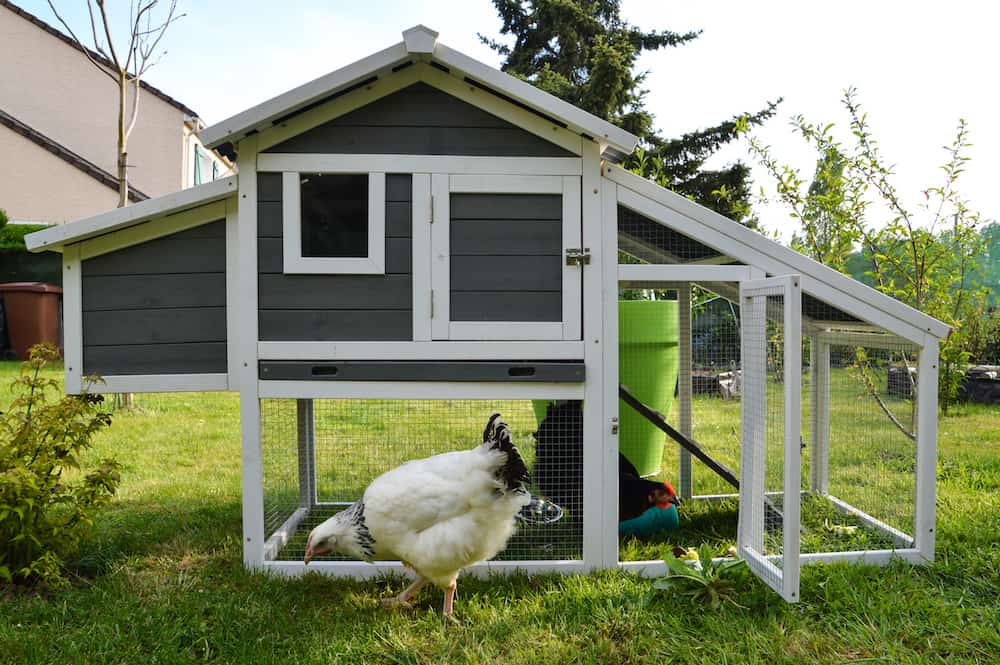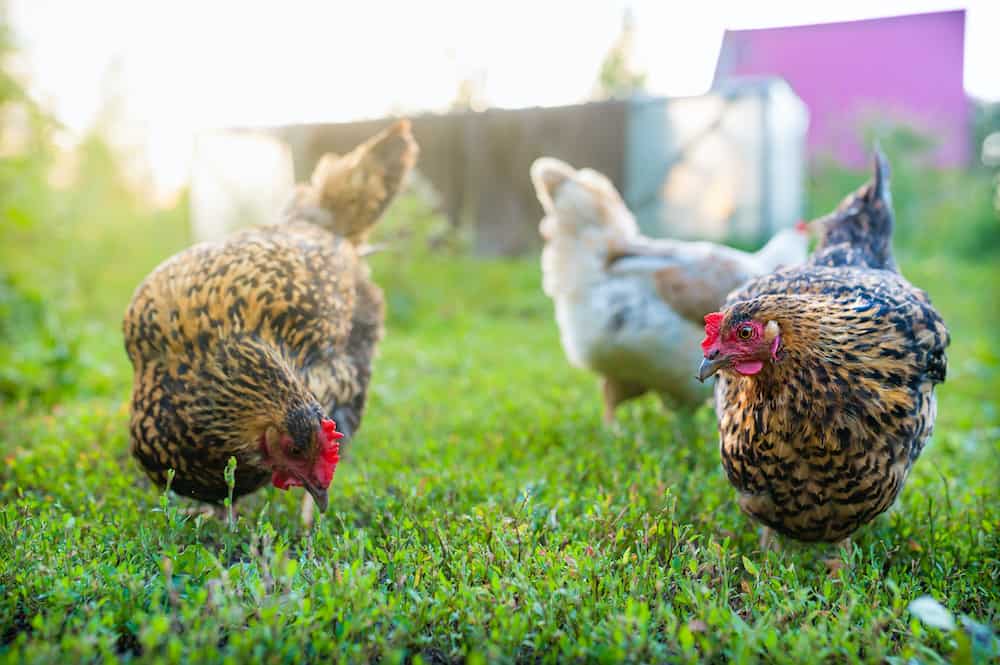Raising chickens is fun, but it can be challenging to get started. Questions like “How much space do chickens need?” and “What do I need to do?” may be overwhelming.
With some patience and a little bit of research, you can get started on your journey into successfully raising chickens. Here’s what you need to know to be sure your chicken coop is big enough.
You’ll learn what size chicken coop, number of chickens, and more.
Whether you want to have a chicken coop size for 6 chickens or space for 12 chickens or more, it’s important to know how much room do chickens need. With these tips in hand, you will be prepared to give your chickens a happy, healthy life!
How Much Space Do Chickens Need?
Chickens need to have enough space to be comfortable, happy, and healthy. If you don’t provide your flock with the right space, it can lead to a lot of problems. Your chickens may suffer from pecking, stress, cannibalism, parasitic infection, and other diseases.
The square footage required for your chicken flock includes two areas. One is an “indoor” space or the chicken coop’s interior. The second is the “outdoor” or the run where the chickens can walk and roam around.
Chicken Math
In the chicken-keeping hobby and when it comes to how much room do chickens need, there is something known as chicken math. Essentially, this form of math says that you should always operate under the assumption that you might take in one or two more chickens in the near future.
Setting up a coop and run that can hold two more chickens than planned gives you room for growth, so keep chicken math in mind while you’re doing your planning.
How Much Space Do Chickens Need in a Run?
The run is the outdoor space that your chickens will spend their time in mostly. Ideally, every chicken should have at least 15 square feet of space in an outdoor run. If you can spare it, though, giving them more room is always a great idea when it comes to outdoor space.
In fact, chicken owners who have larger space prefer to give each of their chicken a minimum of around 25 square feet of space.
Types of Run
Now that you know how large the run should be, you must also start considering the type of run to provide your chickens. Some owners give their chickens free-range run of the garden or a field. That is especially since the chickens will come home to their roost at night once they know where it is.
However, you may need to chase them down to show them where that is at first. You must also remember that allowing your chickens to roam free may put them at risk from predators. Be sure to have the best wire for chicken coops.
Chickens love freedom, but you can give them a similar experience in a large enclosure, by installing a permanent fence, with less risk.
Still, just because the run is enclosed, it does not mean it can be a small area. Some people use portable fencing to keep their chickens secure but change up the area they roam in.
Portable runs are useful, but they are not necessary if you make sure that the outdoor run has enough in it to mimic the wild outdoors. You may want to add some roosts that the chickens can fly to and relax on.
The bottom line is for you to have enough space to avoid space-caused chicken problems. Whether that is a run, a portable run, a field, or a garden, your chickens simply need outdoor space to enjoy.
How Much Room Do Chickens Need Inside the Coop?
The chicken coop is your chickens’ house; this is where they go during rain and in the evening. On average, a coop should have about a minimum of 3 – 4 square feet per chicken. However, it’s important to consider the chicken breeds you will own. Also, if you will be raising a rooster or roosters, they are larger than chickens.
Largest chicken breeds
If you are raising one of the largest chicken breeds, such as Jersey Giants, Brahma chickens, Lavender Orprington or a Buff Orpington chicken, you should plan for a minimum of eight square feet per chicken. Jersey Giant roosters can weigh 15 pounds.
Large chicken breeds
If you have a large chicken breed, such as a Sussex, Rhode Island Red, or Australorp, a minimum requirement is four square feet for each chicken.
Medium chicken breeds
With a medium-sized chickens, such as Sapphire Gem chicken, they will also do well with at least four square feet each. This is true for ISA Brown chickens as well.
Small chicken breeds
On the other hand, if you have a smaller breed, like Bantam chickens, two square feet per chicken can be enough. That means if you own five chickens, you will need at least 10 square feet of indoor space.
Can You Go “Too Big?”
With chicken coops, it’s important that you don’t get something that has too much space for chickens.
It’s okay to give them a couple of extra square feet to roam, but too much space will make it hard for the coop to stay warm. If you live somewhere that it gets chilly or cold, you will want to make sure to consider this.
On the flip side, it is a good idea to get a coop that is a bit too big if you have plans to expand your flock sooner rather than later.
Otherwise, you will need to make structural changes to your coop to fit your flock. Best chicken coops

How About the Space for Perches and Nesting Boxes?
Inside the coop, you need to have nesting boxes and perches for your chickens to rest on. These are essential when you raise backyard chickens.
The chicken nesting boxes can be individual boxes or more of an open box with dividers for privacy, but you should make sure you have nesting areas.
Generally, nesting boxes should have a size of one-foot cube per chicken because if they don’t have enough space, they won’t leave you any eggs. Also, you’ll need to consider the breed sizes you are raising. Brahmas and cochin chickens are larger than others, as an example.
You’ll want to build or buy nesting boxes that can accommodate your largest chicken because you don’t know which box each hen will prefer.
It’s great to have a few individual nesting boxes, but you don’t need to have one per chicken. That is especially since chickens can share their nesting boxes. Many people find that one box per three hens is a good balance.
For perches and roosting, you will want at least 10 inches of perching space per chicken.
Chickens will group closely and use less than this amount of space, but it’s good to have at least 10 inches as a minimum.
Consider the breed
When you are planning shelter for chickens, consider the breed. For example, Jersey Giants and the Brahma chicken are huge. They are giant chickens. These breeds will need more space than a smaller breed or bantams.
If you are raising a flock of Serama chickens, they are tiny. They won’t need as much space.
How Big Should a Chicken Coop Be for Specific Numbers of Chickens?
Based on the information covered above, let’s break down how much space you would need to raise different chicken numbers safely. Hopefully, these examples will help you find how to do the math that you need to set up your own arrangement for your backyard chickens.
How Much Space Do You Need for 12 Chickens?
Here’s what you should expect to set up for 12 chickens:
- At least 36 square feet inside of the coop (48 square feet preferable)
- Minimum of four nesting boxes
- 10 feet of roosting perches
- At least 180 square feet of outdoor space
If you can devote this much space to your chicken flock, you can safely keep 12 happy chickens!
Chicken Coop Size for 6 Chickens
If you only want to have six chickens, how big should a chicken coop be? You can set up this much space:
- At least 18 square feet inside of the coop (24 square feet preferable)
- Minimum of two nesting boxes
- Five feet of roosting perches
- At least 90 square feet of outdoor space
As you can see from the chicken coop size for 6 chickens and 12 chickens, the amount of space that you devote to your flock needs to scale with your chickens.
Can Chickens Stay in the Coop All Day?
Considering the required square footage for chicken coop and run, some might just think of building a coop and let their chickens stay inside all day.
While it is possible to allow chickens to stay in the coop all day, if you have a coop with natural sunlight or artificial lights, we don’t recommend it.
Your flock will be happier and healthier if they go outside daily. Fresh air will benefit them greatly. They like to be active and engaged. Best chicken toys
Going inside at night is reasonable as well, but they need their daily foraging and sunlight. After all, chickens enjoy the outdoors! As you keep chickens, you’ll notice that they sleep in the sun, give themselves dust baths, and more.
Indoor space is essential for protection from the elements and predators, as well as for sleeping. For example, keeping your chickens inside during a blizzard is perfectly reasonable.
Still, outdoor space is essential to the health and happiness of your chickens. You should only keep chickens in the coop all day when you don’t have another option.
Chickens will often resort to bad behaviors like fighting if kept inside in a small space too long, so keep this in mind, as well.
It would also be best to measure your available space before thinking of the number of chickens to take care of instead of the other way around.
Chicken Coop Size and Space: Do Your Math!
Determining the amount of space that you need for your chicken flock is very important. While you’re doing your math, it is essential to consider if you want to add more chickens to your flock down the line.
Many people end up adding chickens over time, so keep in mind that you might need to make adjustments later on.
Still, you can start with just enough space for your desired number of chickens. From there, just remember to make changes over time as needed based on how much space chickens need.
Once you get going, you’ll find that the learning experience is just as valuable. You can get creative with space for chickens, even opening up their area to a garden or other area you may not have considered.
Learn more:
- Best egg-laying chickens
- Best meat chickens
- What I wish I knew before getting chickens
- 10 tips for raising backyard chickens for beginners
- 9 things to consider before raising chickens
- How to keep chickens cool in the summer heat tips for beginners
- Chickens laying eggs with no shell
- Why can’t chickens fly

